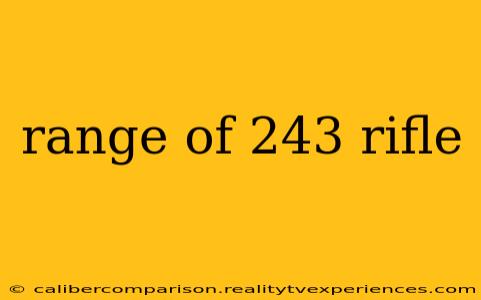The .243 Winchester, a popular cartridge known for its versatility, is frequently used for hunting a variety of game animals. Understanding its effective range is crucial for safe and ethical hunting practices. This isn't simply a matter of how far the bullet will travel, but rather how far it will travel with sufficient accuracy and retained energy to reliably achieve its intended purpose.
Factors Affecting Effective Range
Several factors significantly influence the effective range of a .243 Winchester rifle:
1. Bullet Selection:
- Bullet Weight: Heavier bullets generally retain velocity and energy over longer distances, extending the effective range. Lighter bullets are better for shorter ranges and flatter trajectories.
- Bullet Construction: Different bullet designs (e.g., boat tail, hollow point, full metal jacket) impact ballistic performance. Boat-tail bullets, for instance, often exhibit improved accuracy and longer ranges due to their reduced drag.
- Ballistic Coefficient (BC): This measures a bullet's ability to overcome air resistance. A higher BC means less velocity loss and a flatter trajectory at longer ranges.
2. Rifle and Scope:
- Rifle Barrel Length: A longer barrel generally translates to higher muzzle velocity and thus increased range.
- Rifle Accuracy: A rifle's inherent accuracy significantly impacts its effective range. Inaccurate rifles will lose precision long before the bullet loses sufficient energy.
- Scope Quality and Magnification: A high-quality scope with sufficient magnification is necessary for accurate aiming at longer ranges.
3. Environmental Conditions:
- Wind: Wind significantly affects bullet trajectory, especially at longer ranges. Strong winds can drastically reduce accuracy and necessitate significant adjustments to aim.
- Temperature: Temperature changes alter air density, affecting bullet velocity and trajectory.
- Altitude: Higher altitudes mean lower air density, impacting bullet performance similarly to temperature.
4. Shooter Proficiency:
- Shooting Technique: Proper shooting technique is paramount for consistent accuracy at any range. Factors like proper stance, breathing control, and trigger squeeze are crucial.
- Zeroing: Accurate zeroing of the rifle and scope to the specific ammunition being used is fundamental for reliable shot placement.
Defining "Effective Range"
The effective range of a .243 Winchester isn't a single definitive number. It depends on the variables discussed above. Generally, however, the maximum effective range for hunting is considered to be around 300-400 yards for medium-sized game, provided all the factors above are optimized. Beyond this, accuracy and energy drop become increasingly unpredictable, making ethical and humane shots increasingly difficult to guarantee.
For smaller game, a shorter effective range may be more appropriate. For larger, tougher game, hunters may opt for heavier bullets and consider a different cartridge entirely for distances exceeding 300 yards.
Practical Considerations
Even within the effective range, several factors need careful consideration:
- Shot Placement: Accurate shot placement is paramount. A poorly placed shot, even at a relatively short range, can lead to a wounded animal.
- Ethical Hunting Practices: Hunters should never take a shot unless they are confident in their ability to make a clean, humane kill.
In conclusion, the effective range of a .243 rifle is not simply a figure but a complex interplay of factors. Understanding these factors and practicing safe and ethical shooting techniques is crucial for hunters utilizing this versatile cartridge. Always prioritize safety, accuracy, and ethical hunting practices above all else.

